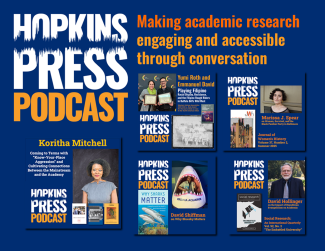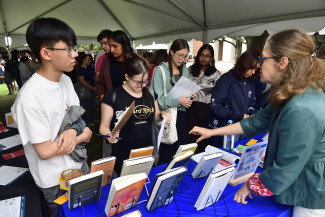
Johns Hopkins UniversityEst. 1876
America’s First Research University
How Humanities #StepsUP for STEM via Project MUSE

While many scholars, librarians and academicians are aware of Project MUSE as a resource for scholars in the Humanities, there is additional benefit in providing access to the large volumes of content on MUSE to inform Science Technology Engineering Math (STEM) scholarship.
Take the fact that in recent years, there have been several articles declaring the Humanities as a diminishing major on university campuses. Perhaps the most talked about was way back in 2023 and in The New Yorker, “The End of the English Major”. It even prompted an internal conversation here at Johns Hopkins University Press, in what we call a “Let’s Chat” where Press Director, Barbara Kline Pope, hosted an online conversation to hear the staff’s thoughts on the subject.
It was not long after the New Yorker piece ran when a Washington Post article led with the line, “Two trends in higher education nationwide are colliding at the University of Maryland: booming enrollment in computer science and plummeting student demand for the humanities”. The reporter provided some stark national stats to support his thesis:
“The number of students nationwide seeking four-year degrees in computer and information sciences and related fields shot up 34 percent from 2017 to 2022, to about 573,000, according to the National Student Clearinghouse Research Center. The English-major head count fell 23 percent in that time, to about 113,000. History fell 12 percent, to about 77,000.”
While numbers like those seem ominous, there is a way for Humanities to continue its vital importance and STEP UP by creating new pathways for connections and engagement among STEM studies.
Humanities provide STEM with a depth and richness it can thrive upon.
If you saw the Oscar-winning film, Oppenheimer, you learned of his scientific skills and mathematical abilities. But what was not stressed nearly as much was how his upbringing was steeped in art, culture, and the humanities (his family home included works by Picasso, van Gogh, and he was trained at the Ethical Culture School). When he entered Harvard he studied history, literature, and philosophy along with chemistry.
His experience on The Manhattan Project and the resulting Atomic bombs with their destructive power led him to lobby vigorously for arms control and against the development of the H-Bomb. He Stepped UP. You can read about this later phase of his life from 1949 to 1955 with a book from Johns Hopkins University Press, The Ruin of J. Robert Oppenheimer and the Birth of the Modern Arms Race, which details when Oppenheimer and a group of liberal scientists tried to head off rival scientists who were trying to seize control of U.S. policy and build even more deadly nuclear weapons.
There are several more articles and books on Oppenheimer you can discover and #ReadUP on MUSE.
It’s well known that it was his friend and colleague, Albert Einstein, whose moral stance due to his own pacifist beliefs declined participation in The Manhattan Project, foreseeing the inevitable destructive power of his formula e=mc2.
Without their foundation in humanities, two of the greatest scientists in the history of the 20th century may have made calculations far more destructive.
As access to technology is becoming more ubiquitous today, you may be reading this article on your iPhone or iPad. But did you know it was the founder of Apple, Steve Jobs, who drew from his travels through India in 1974, seeking enlightenment and later studying Zen Buddhism creating one of the most valuable companies in the world? Read about the religious elements of the Apple phenomenon on MUSE as it relates to individuality, creativity, and counterculture. This system of beliefs is supported by a mythos surrounding Apple’s history and Steve Jobs’s life and his visionary use of media to explain technology to a hungry culture that revealed his singular genius.
Moreover, despite its frequent association with B-movies about space aliens and other assorted strange phenomenon, the study of science fiction has informed real science countless times, from the prolific author and early Sci-Fi path maker H.G. Wells to the recent Sci-fi series on Netflix, 3 Body Problem. This series posed the situation of an astrophysicist who makes the fateful decision to contact an alien planet setting off a current day confrontation against humanity’s ultimate threat.
While Oppenheimer, Einstein and Jobs are all real people, the fiction in science fiction has a way that helps us wrestle with technology while letting us dream of what’s to come. Any study of STEM would benefit from understanding more about science fiction. MUSE has journals dedicated to the study as it relates to scholarly and intellectual communities of film studies and Technoculture and Science Fiction, Afrofuturism, Latin American Science Fiction, and Animal Studies and Science Fiction.
Genres of fiction, literature, and philosophy have also been known to influence engineering. Note the designs of Frank Gehry that have been influenced by the philosophy of Deconstruction as evidenced by his countless engineering structures. In fact, the study art and art history infuse his work by intertwining giant strips of stainless steel in buildings as magnificent as The Lou Ruvo Center for Brain Health of the Cleveland Clinic to the Guggenheim Bilboa in Spain. To gain an even greater appreciation and understanding of Gehry and his style, you can explore many more insigthtful articles also on MUSE.
Contrary to the New Yorker and Washington Post articles, there are institutions embracing this amalgamation of humanities and science, including a new campus Hub at Johns Hopkins University combined major in Medicine, Science and the Humanities and a brand new one that Fuses Arts and Tech at Rochester Institute of Technology.
For librarians, scholars, academic publishers and those in academia who are met with students of STEM who may not be aware of the many reasons to infuse their studies with MUSE’s comprehensive catalogue of humanities content, we encourage you to provide access to this valuable resource. It will enhance their research, enrich their work, and just might help humanity.
Reach out and #StepUP to learn more about our humanities resources and sign up for our newsletter to stay informed.


